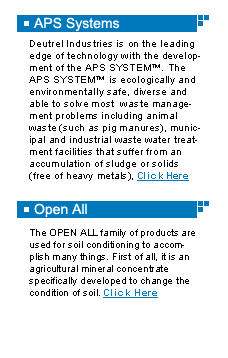SELMA RESEARCH CENTER
AGRICULTURAL (M) SDN BHD
FIELD EFFICACY OF OPEN ALL® ON TURF GRASSES
PLANTED ON A TERRACE WITH A 30° TO 40º SLOPE
AUTHORS:
OMAR BIN CHE MAY
ZAININ BIN MOHAMAD
AFIZOL ABU BAKER
Introduction
Exposed soil surfaces are recommended to be turfed to prevent wash-off by heavy rain that lead to undesired soil erosion. Consequences of soil erosion are landslides, silting of rivers and floods.
The major species of grass in Malaysia for ground cover are Cow grass (Axonopus compressus), Bermuda grass (Cynodon dactylon), Zoysia grass (Zoysia matrella), Bahia grass (Paspalum notatum), and the very commun weed, Lalland (Imperata cylindrica).
Roots function to anchor the plants and to absorb water as well as nutrients from the soil. Deep roots that penetrate into the ground in search of ground water and for survival from winter frost are a characteristic of plants found in the temperature zone.
However as a result of the local hot and humid weather conditions, plants had adapted their root systems to become shallow and extensive for quick water absorption after a tropical thunderstorm which is heavy and quickly runs-off. Hence during a drought, we often witness rapid wilting and browning of turf grasses coupled with shedding of leaves from trees. A deep and extensive root system is essential for good turf establishment and to anchor the soil surface.
OPEN ALL® functions as a soil revitalizer and conditioner. It is an electrolyte containing 8 essential elements, 7 micronutrients, and 63 trace elements, and augmented with certain living amino acid chains. OPEN ALL® improves chemical and physical properties of soil, permitting excellent water percolation by molecular attraction which allows water to move freely and uniformly down into the soil. Thus, plants will get the required nutrients from the soil and will normally save 50% in water use along with 50% in fertilizing requirements.
Therefore, it is the objective of this trial to demonstrate the field efficacy of OPEN ALL® soil treatment in promoting a healthy root and shoot system for the major turf grass species planted on a slope of 30 to 40 degrees to the ground.
TRIAL METHOD
Dosage of OPEN ALL®: 40 ml/m²
Method of application: 240 ml of OPEN ALL® was diluted into 4.8 liters of water. The solution was then drenched evenly onto the soil surface until just before run-off. Later 20 liters of water per plot was used to drench over the treated area, to allow penetration of OPEN ALL® to reach a column depth of 20 cm. Similar amount of clean tap water was drenched onto the untreated control. The plots are watered daily in the morning and late evening.
Planting method: Turf grasses with sod size 15x15 cm. were then planted on the OPEN ALL® treated plot and on the untreated plot at a distance of 15x15 cm. apart.
Results and discussions: Assessment on the average length of new roots, average number and length of new shoots were presented in table 1, 2, and 3 (found below). Plates 1 to 10 (found below) showed the field efficacy of OPEN ALL® at 21 and 35 days after treatment (DAT).
We observed excellent and fast response by turf grasses planted onto soil treated with OPEN ALL® at 40 ml per meter square.
At 21 DAT, Bahia grass showed the highest increase of 121.1% for average length of new root, followed by Zoysia grass (113.9%), Bermuda grass (110.2%), Lallang (61.5%), and Cow grass (28.6%) when compared with untreated control.
However, judging from the spurt in the average length of new roots when compared to before planting, Bahia grass showed the highest increase of 317%, followed by Cow grass (215.8%), Bermuda grass (209%), Zoysia grass (157.7%), and Lallang (110%).
From table 2 (found below), Bahia grass at 21 DAT topped the list with 156.1% increase in the average number of new shoots per sod, followed by Cow grass (65.1%), Zoysia grass (43.6%), Bermuda grass (43.5%), and Lallang (29.6%) over untreated control. However at 35 DAT, Cow grass sprouted to give the highest number of new shoots of 186.2% increase over untreated control.
Table 3 (found below) showed that OPEN ALL® promotes elongation of new shoots as demonstrated in the increase of 162.2% for Lallang, 87.5% for Zoysia grass, 35.7% for Bahia grass, 22.2% for Cow grass, and 15% for Bermuda grass.
These results evidently showed the efficacy of OPEN ALL® in promoting root and shoot formation and elongation in turf grasses grown in our fairways, parks, gardens, playing fields and hill slopes.
Conclusions:
1. Soil treated with OPEN ALL® at 40 ml/m. sq. showed improvement in soil structure and water retention which enhanced development of planted turf grasses.
2. On OPEN ALL® treated soil, all tested turf grass species, Axonopus compressus (Cow grass), Cynodon dactylon (Bermuda grass), Zoysia matrella (Zoysia grass), Paspalum notatum (Bahia grass), and Imperata cylindrica (Lallang) responded tremendously well and fast in the formation of new shoots and roots.
3. At 21 days after treatment (DAT), over 100% increase in average length of new roots were recorded for Bahia grass, Zoysia grass, and Bermuda grass over untreated control.
4. Similarly, the percent increase in the root length over the initial length before planting exceeded 300% for Bahia grass, 200% for Cow grass and Bermuda grass, and 100% for Zoysia grass and Lallang.
5. Better root system correspondingly support a higher number of new shoots per sod. 151% increase was observed for Bahia grass, 65% for Cow grass, 43% for Zoysia and Bermuda grass, and 29% for Lallang.
6. Deeper and dense root systems coupled with healthy luxuriant shoots for planted turf grass will provide an excellent anchoring and cover for exposed soil surfaces especially on steep slopes. Treated turf would be able to tolerate heat stress better and recover faster from traffic compaction an injury.
7. OPEN ALL® provides the extra edge to promote faster establishment of ground cover and deeper root system in the control of soil erosion.
Back to
OPEN ALL>
|

